Amateur Astrophotography
Skywatcher Skymax Maksutov-Cassegrain f = 1500mm / D=127mm F12 SynScan AZ GOTO
Skywatcher Skyhawk Newtonian f= 500mm (450mm) / D=114mm F4
Skywatcher Explorer 130PDS Newtonian, f=650mm / D=130mm F5 with Skywatcher Mount EQ5 Pro SynScan GoTo
The moon is one of the most rewarding targets in the sky. It offers plenty of light and a terrific amount of details. If you think the moon is boring because it is the closest object in the sky, and an already overstudied thing from many years ago, you are wrong. Discover the pleasure of rediscover! Watch it carefully and discover the moon all by yourself. You have a full world in your eyes.
Our telescope has a resolution 0f 0.91". Our camera has pixels of 2.9 x 2.9 microns at a focal distance of f=1500mm. The moon distance is about d = 384,400 Km. How big are the details that we can see? Let's do some very simple trigonometry. 0.91" correspond to 1.7 Km. Not bad!
How many Km in, lets say, 10 pixels? The answer is 7.43 km. With a 2X Barlow 10 pixels are 3.72 Km.
This is what we could get with a perfect seeing. Not bad! We can get ready to land on the moon! Field of view of the camera sensor is 12.9' X 7.2' without Barlow. That is an area of 1442 Km x 805 Km. With 2X Barlow we have an area of 727 Km X 403 Km.
The following pictures were taken on 5 October with a 2X Barlow (not a good decision with quite a bad seeing). Processed with Autostakkert-Fitswork-GIMP. Final result is as usual, better than expected. To get HD image left click with mouse on "view image"
Tall Craters
Close inspection of this image reveals how tall and thin are the crater walls in the upper part. Some terraced structure is visible. From the outside the walls look very steep. This image shows fine 3D details of the craters, thanks to shadows. Notice that the upper inner side of the crater walls are highly reflecting, while the outer part is far darker. That difference is amazing. This is my first discovery! So enjoyable!

Mare Nectaris
Notice the craters on the left of the mare. Mountains in the central part of the craters have quite random shapes. Some are single mountains, some are a set of mountains. If you check the image in full resolution, you will notice so many small craters on the mare. The mare itself is far from being flat.

Funny central peak on crater
Please check the funny shadow of the biggest crater of the next image. Can we guess the shape of the central mountain? Incredible formation from an impact! We can see very well terraces on the walls of the craters. Notice the extremely long ridge that seems to originate on the west side of the crater.

Craters on crater
It is not uncommon on the moon to find craters inside craters. A quite interesting example can be found in the following image. Even In the inner walls of the biggest crater of the image, impacts are clearly visible. Notice many craters lack central peak.
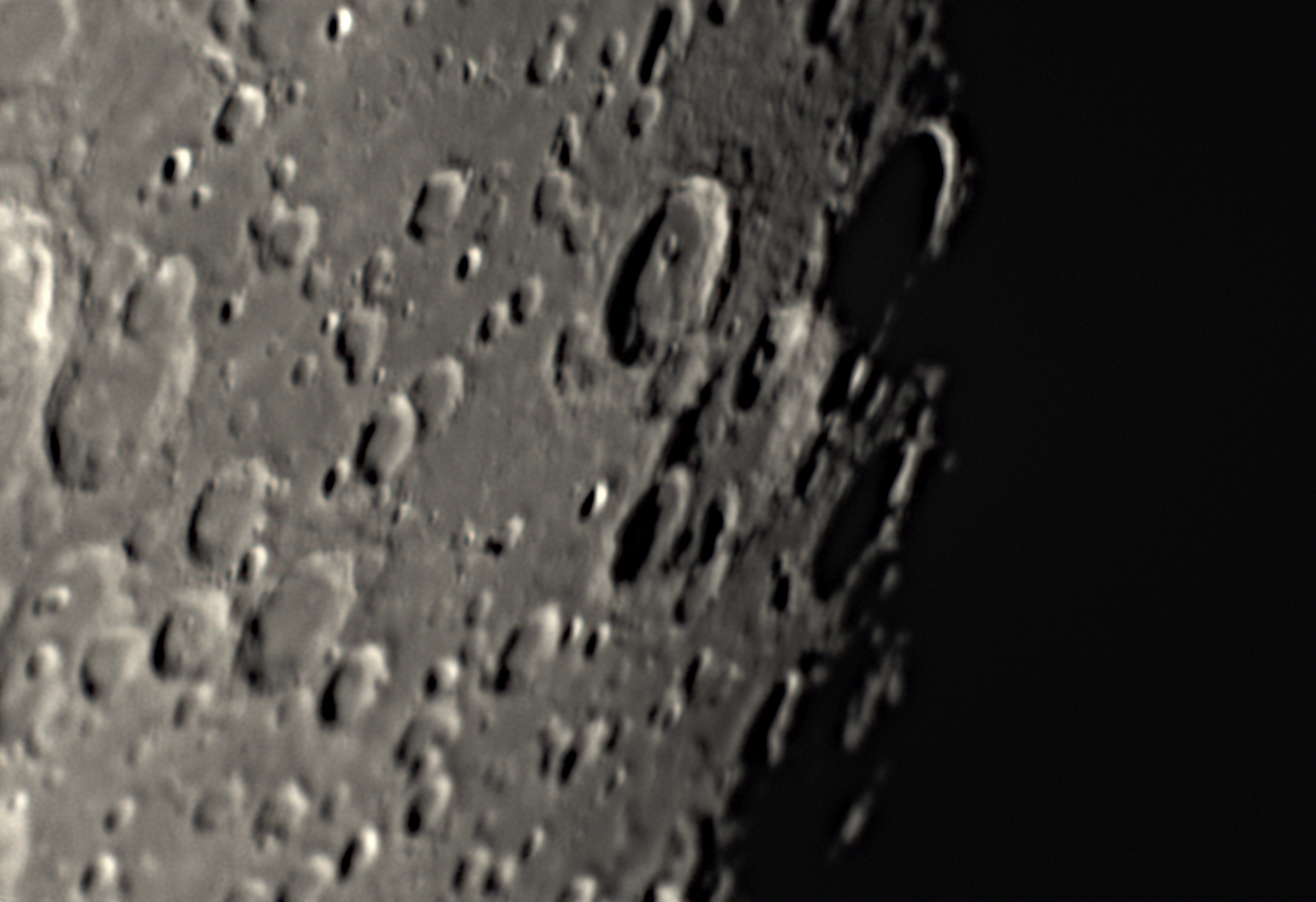
Tycho Crater
Please compare the shadows of craters around the Tycho crater. It seems Tycho crater is big but the walls are not very tall. Actually they look quite affected by other impacts on the west side.

The following pictures were taken on 21 and 22 November
Mountains on the Moon
On the left side of Mare Serenitatis there are two ridges, on the north "Montes Caucasus", on the South "Montes Apenninus". Mountains look tall, narrow and very sharp. On Mare Serenitatis we can see six small craters in a row. There are so many grey spots, probably smaller craters.

Montes Apeninus, Rima Hyginus, Rima Ariadaeus
In the south of Montes Apeninus, we have Mare Vaporum, and things get very interesting. It looks like there has been some flow of a liquid, probably lava, from north to south.
Also, we can see "channels", actually called "Rilles". One of them has a tiny caldera, (of volcanic origin?) in the middle. It is called Rima Hyginus and branches to the northwest and to the east-southeast for a total length of 220 Km and a width of about 4Km, quite a valley!. Another huge rille is Rima Ariadaeus.
On the South of Montes Apeninus we have Sinus Medii, a small Mare. Its mountains on the north look so really steep and sharp. Some of them belog to craters. In the middle of Sinus Medii we have Crater Triesnecker, with a diameter of about 25Km. Its walls look so steep. And around it nothing is flat. We can see rilles and wrinkles...
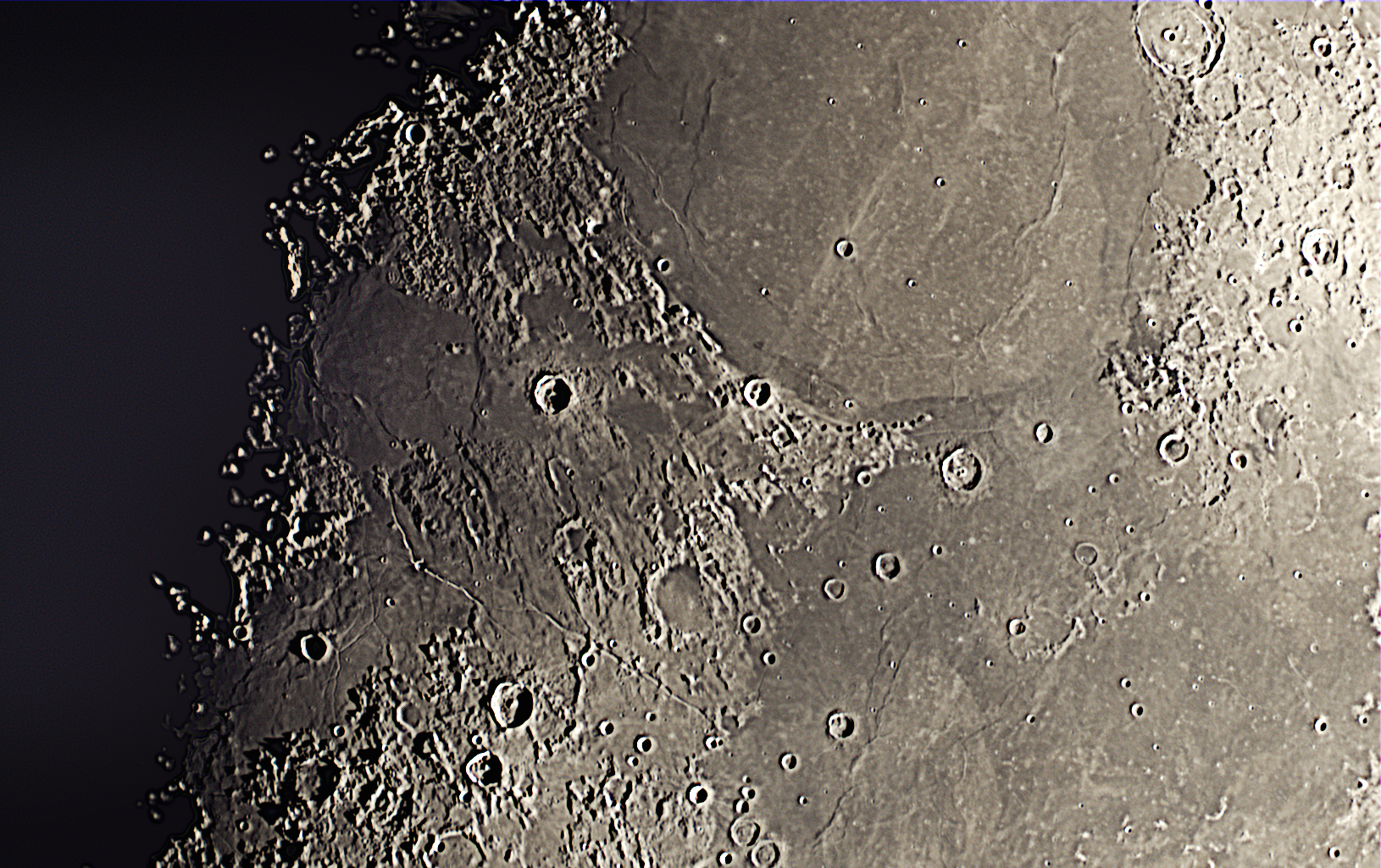
Craters Teophilus, Cyrillus and Catharina
Catharina in the south is clearly the oldest, and Theophilus is the youngest. Cyrillus is next to Teophilus. The level of detail of this picture is really impressive. It looks like we are about to land in the area.
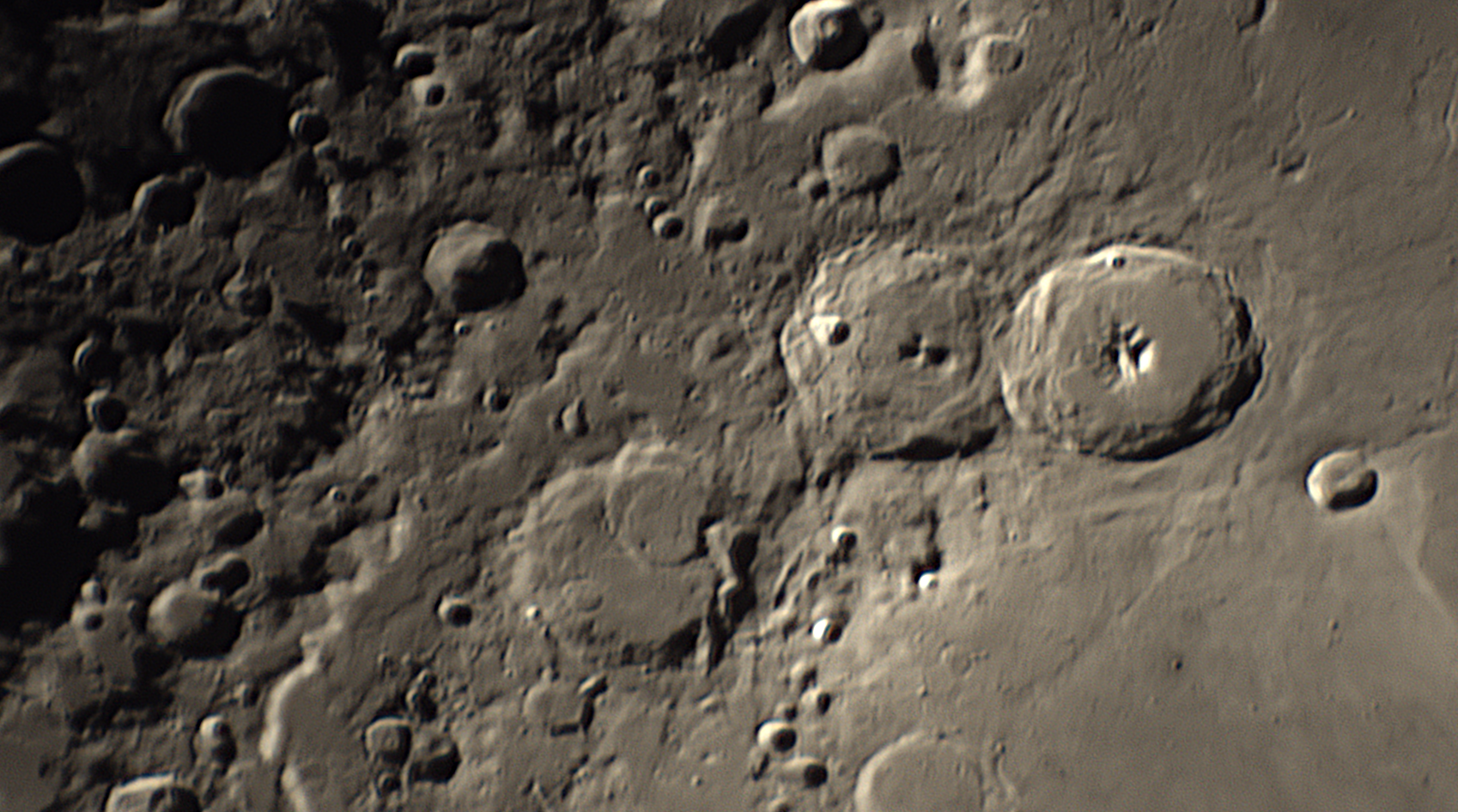
In the next picture we can see the location of the craters, between Sinus Asperitatis and Mare Nectaris
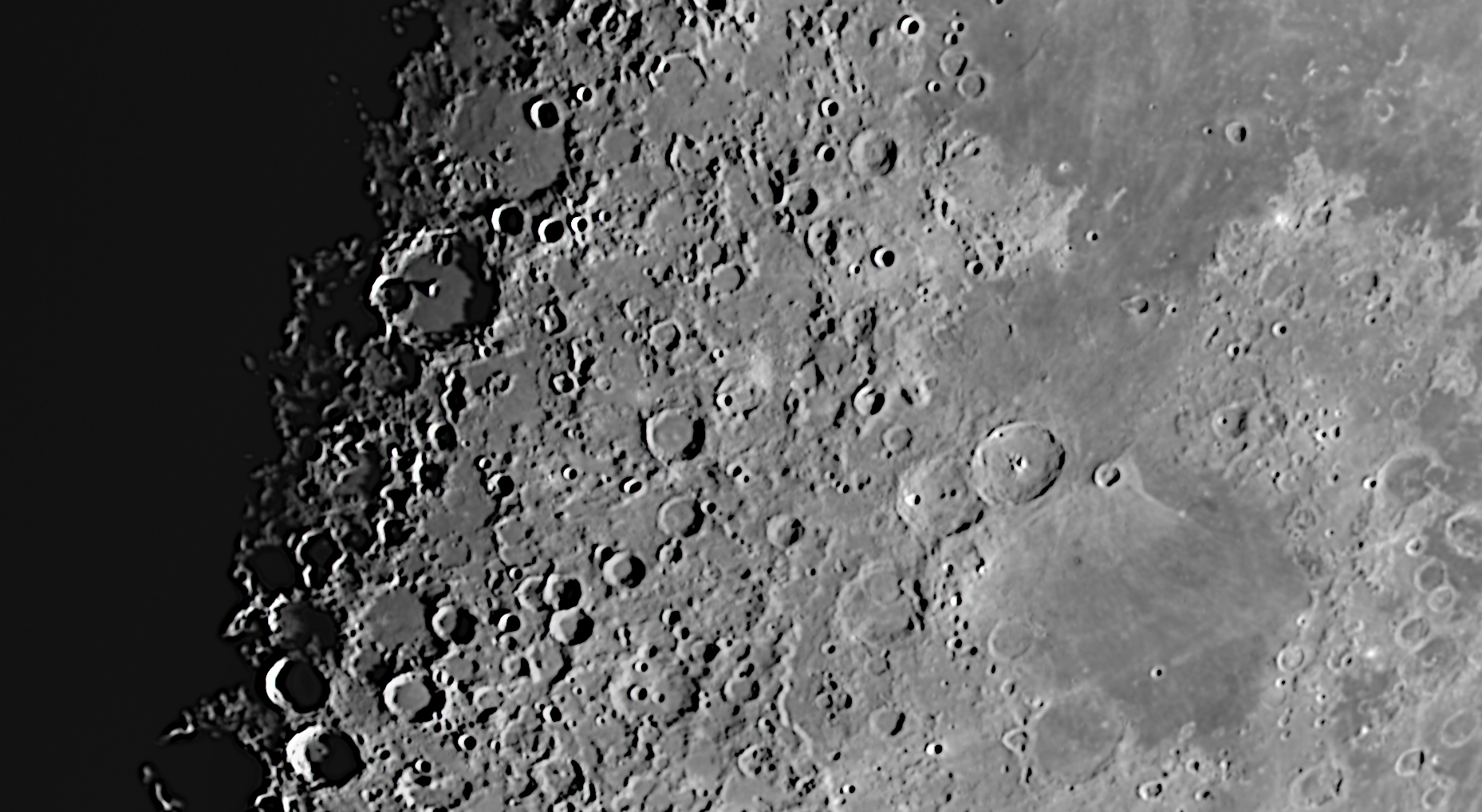
Montes Apeninus, Montes Caucasus, Montes Alpes, Vallis Alpes
From south to north: Montes Apeninus, Montes Caucasus and Montes Alpes. Bisecting Montes Alpes we can see a huge valley, called Vallis Alpes.

Another picture taken more in the north:
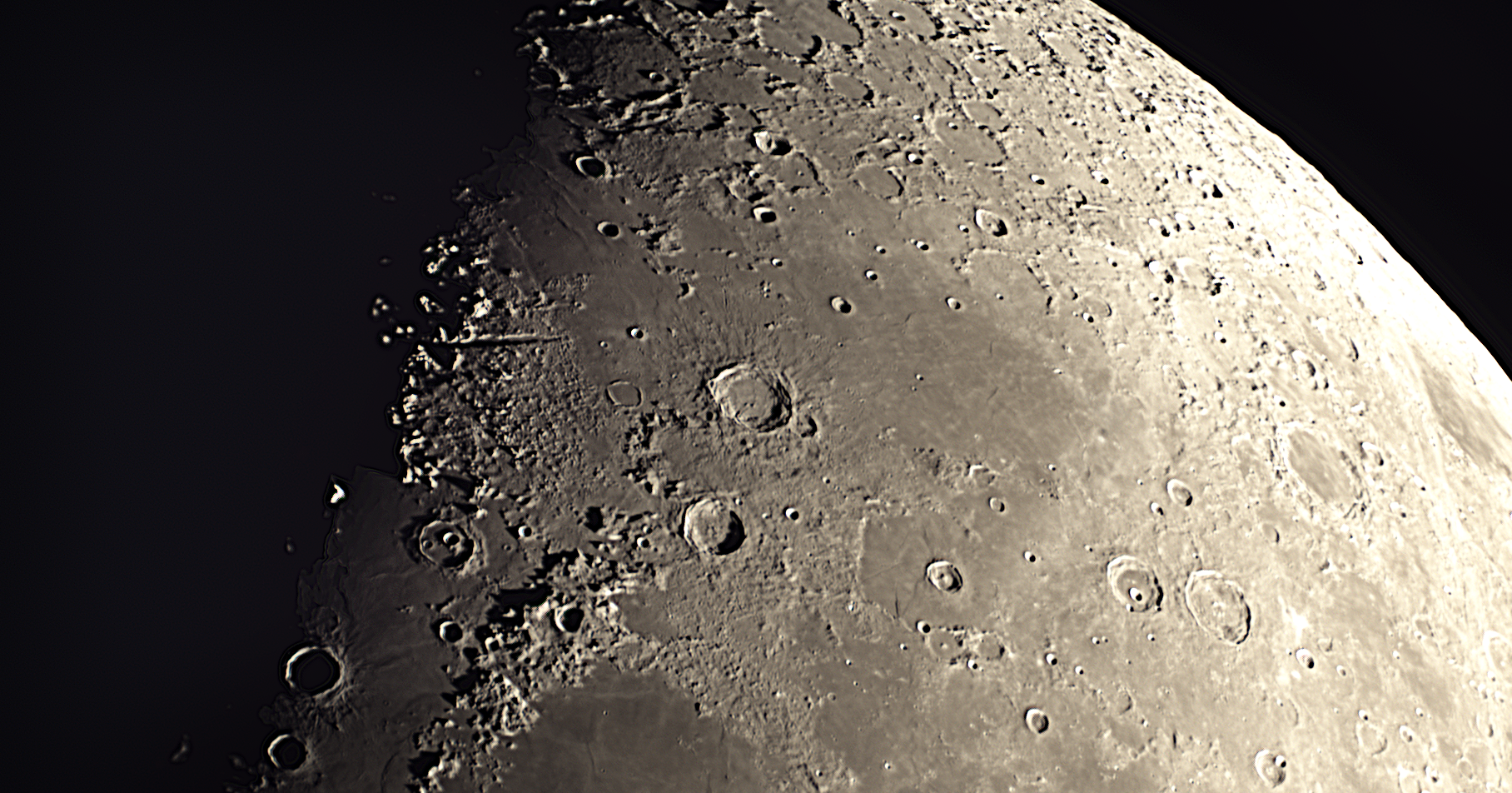
The biggest crater is called Aristoteles Crater and the one in its south is Eudoxus Crater. On the left of Eudoxus Crater, with two craters inside, is Cassini's Crater. Let's enjoy a closer look to Aristoteles Crater and Eudoxus crater:

2022
The Moon has colors.
The regions we call Mare are dark regions rich in iron oxide and titanium dioxide.If you look at the photo, Mare Serenitatis (top left) shows a dark reddish color, indicating the presence of iron oxide. Instead, Mare Tranquilitatis, just below Mare Serenitatis, is even darker and shows a bluish hue, indicating the presence not only of iron oxide, but also of titanium dioxide.
The photo was taken in the early hours of August 13, so the moon was very low and visibility was not very good (there was fog). I took the photo to try to see what can be obtained in those conditions and it didn't turn out too bad.

Lunar Landscapes: Mare Nubium
In the heart of Mare Nubium we find the Bullialdus Crater, in honor of Ismaël Bullialdus, a 17th-century French astronomer and mathematician. The crater is 61 km in diameter and 3.5 km deep. What an impact! Enjoy the detailed structure that the image offers. This crater is relatively isolated, which allows us to observe its structure very clearly. The interior walls are structured forming the typical terraces, ideal for sunbathing. The exterior part of the walls is in the shape of a ramp, and is dotted with a wide mantle of ejecta that has given rise to a radial pattern of crests and low valleys. In the central part there are several peaks that rise to more than a kilometer in height. Ideal for experienced climbers.
If you continue down the slope on the right hand side, near the edge of the image, you will come to "Straight Rupes", which appears as a prominent white line. In truth, it is a huge fault of 110 km in length and offers a drop that varies between 240-300 meters. Be careful, because the black line you will find before reaching "Rupes Straight" is a channel or fissure called "Rima Birt", and it is about 50km long and 1.5km wide. The depth is unknown to us, so be careful not to fall.

Lunar Landscapes: The Crater Copernicus
It is one of the main craters on the Moon. It receives its name in honor of the Polish astronomer Nicholas Copernicus. Located in the middle of Oceanus Procellarum, it is a relatively recent crater (less than a billion years old), so it has remained relatively intact since it was formed. Its diameter measures 93 km. The crater floor is at a depth of 3.8 km. The pointed mountains that rise from the center of the crater have a height of 800 meters.
To the north of Copernicus are the Montes Carpatus, which lie at the southern end of the Mare Imbrium. This mountain range has a length of about 360 km and an average width of 60 km, with several summits of 2,400 m in altitude. They constitute part of the old wall of the crater that originated the Mare Imbrium. West of Copernicus is a group of scattered lunar hills. In the northeast we see the Tycho crater and the "Mons Wolf" mountains, which constitute the southwestern end of the Montes Apenninus.

Lunar Landscapes: The Rainbow Bay (Sinus Iridum)
If you are thinking of going on vacation to the Moon, you will not find a better destination. Sinus Iridum, the Rainbow Bay, will surprise you with the beauty of its coastline and the imposing mountains that surround it. The calm waters of the bay belong to the Mare Imbrium.
The capes "Promontorium Heraclides", to the east, and "Promontorium Laplace" to the west, limit the bay with their imposing peaks, 1,700 and 2,500 meters high respectively. The Jura Mountains surround the bay, forming a 400 km long mountain range with peaks exceeding 6,000 meters in height, which guarantees that you can enjoy endless walks in the light of the Earth. And as if that were not enough, in the aforementioned mountain range, you will find the Bianchini crater, with 40 km in diameter and a depth of 3000 meters.Go ahead and remember to make your reservations well in advance.

How fun it is to get the colors out of the Moon to see the mineral content, especially iron (red) and titanium (blue). Of the three that I have shown today, the most spectacular image is that of Sinus Iridum. So I show it reprocessed to show the splendid color of the seas and mountains.

Lunar Craters: Longomontanus
Longomontanus is an ancient crater located far to the south, southwest of Tycho. It receives this name in honor of Christen Sørensen Longomontanus, a contemporary Danish astronomer of Keppler. Due to perspective, Longomontanus appears to be oval in shape. It has a diameter of 145 km and a depth of 4.5 km. The crater walls are heavily weathered and at the top are nearly level with the surrounding terrain. The north side is affected by multiple overlapping craters. To the east is a semicircular ridge that has the appearance of the rim of another, older crater. Inside the crater we find a group of short peaks quite displaced to the west.
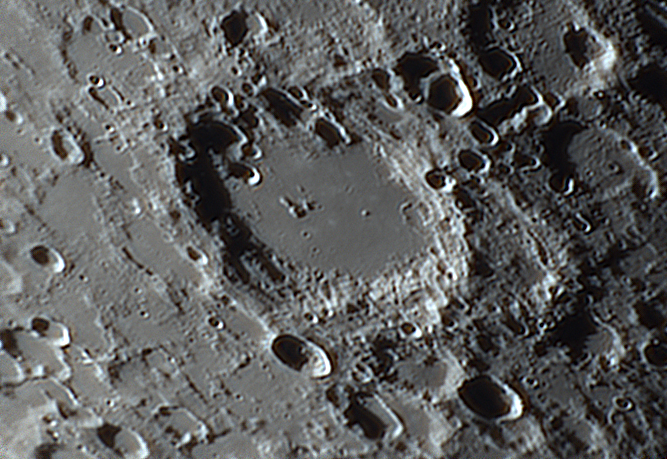
The Moon: Harbinger Mountains. Sometimes I go for a walk with my little Maksutov to explore the lunar terminator, and I find surprises like this: a group of isolated mountains called "Harbinger Mountains", located on the western edge of the Mare Imbrium. It is immediately striking to see those long shadows and the curious distribution of the main mountains and those small peaks placed two by two. How nice it would be to be able to land there and be able to take a good walk. Image taken on September 7 with the Moon at about 20º above the horizon.

Lunar terminator: Gassendi crater. The Gassendi crater is located on the northern rim of the Mare Humorum. It measures about 110km in diameter. The crater wall varies in height from as little as 200 meters to a maximum of around 2.5 kilometers. In the central region several peaks are observed and the highest is approximately 1.2 km high. The crater was flooded with lava during the formation of the Mare Humorum, so the floor is covered with solidified lava. There are several mounds scattered throughout the interior, and in the southern part of the floor a concentric ridge with the outer edge is clearly visible. This ridge is not particularly high or steep, but there are some peaks that rise more than a kilometer above the deepest part of the ground. A very notable feature of the interior of Gassendi is the presence of numerous long and narrow depressions (rima) as channels. The main ones can be seen in the photo.

